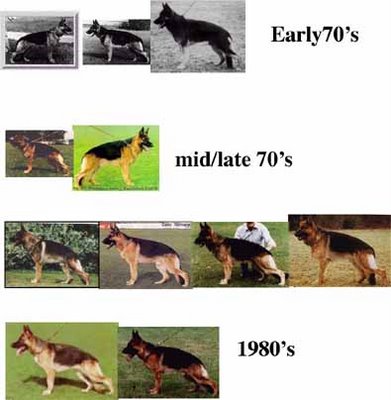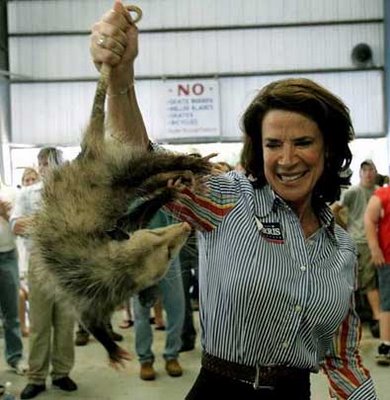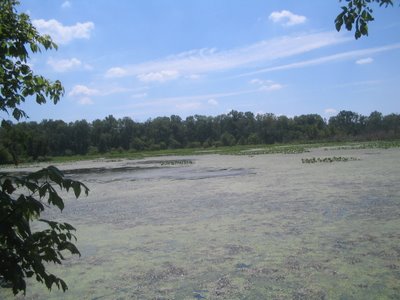
Asking me my thoughts about dog training is a bit like asking a rodeo clown to bring in the herd: I might know my way around a cow, but I might not be quite what you need for this job.
And so, it was with some confusion that I got a call from my mother asking me what I thought of the article on Cesar Millan (the so-called "Dog Whisperer") in this morning's New York Times.
I had not see it.
A bit later, I got an email from Reid Farmer asking, "Who's gonna jump on this one?"
Well hell, I guess I will. If deep knowledge and expertise are required to type, there would not be too many typing classes.
So here goes. What does this New York Times piece criticizing Cesar Millan and "The Dog Whisperer" TV show actually say?
Here's the meat of it:
"Essentially, National Geographic and Cesar Millan have cleverly repackaged and promoted a simplistic view of the dog's social structure and constructed around it a one-size-fits-all, cookie-cutter approach to dog training. In Mr. Millan's world, dog behavioral problems result from a failure of the human to be the pack leader, to dominate the dog (a wolf by any other name) completely.
"While Mr. Millan rejects hitting and yelling at dogs during training, his confrontational methods include physical and psychological intimidation, like finger jabs, choke collars, extended sessions on a treadmill and what is called flooding, or overwhelming the animal with the thing it fears. Compared with some training devices still in use whips and cattle prods, for example these are mild, but combined with a lack of positive reinforcement or rewards, they place Mr. Millan firmly in a long tradition of punitive dog trainers."
Aha! Now I get it. Millan is a "bad and backward" punitive dog trainer! The author of The New York Times piece slyly manages to work in whips and cattle prods to suggest Millan is one of those types of trainers.
But wait a minute! What Mr. Millan actually does is simply use an ordinary choke chain as it should be used, a firm voice and a firm hand to get a dogs attention. There are no beatings of dogs here. This is the National Geographic Channel, for God's sake!
The over-educated yuppies who watch this channel do not have a problem being too coercive. Their problem is that they think of their dogs as human children and they are willing to have themselves and their children bitten rather than try to communicate with the dog as a dog.
Whatever a dog is, it is NOT a human child.
But, of course, this is news to a lot of folks that watch the National Geographic channel, Animal Planet, and public television. These are nice people who love their pets. Most of them have sat on the couch so long watching nature shows they think real-life lion kills in the Serengeti are narrated, sotto voce, by the same voice that announces par scores on the Golfing Channel.
But no matter how nice or over-educated you are, a dog is not a child. This is a particularly uncomfortable and threatening truth for women who have managed to displace their maternal instincts to the family pet. This is a point Millan does not address directly (please, not too much honesty Millan!) but he does suggest women often have a harder time asserting dominance over their "fur babies." He is right. Why does saying this obvious thing send Mark Derr clucking away like a hen? Anyone who works with dogs has seen the maternal displacement problem in action, and anyone who has seen the "Dog Whisperer" TV show has seen the problem repeated out again and again. The Daisy Fuentes episode was particularly memorable for some reason ....
The simple but harsh truth is that the psycho-demographic watching the National Geographic channel tend to be people with two types of common "dog problems": They think their dog is their child, and their dog is over-fed and fat.
The dog is, quite simply, being "loved to death."
Cesar has antidotes for both problems. He is the right wrench for this nut.
If Mark Derr, the author of the New York Times editorial, wants to put together a TV show about dog training his way, he is free to do it. But it will not be a show that makes it on air unless it is entertaining. And dramatic. And has a charistmatic human figure as the lead.
Can Mr. Derr supply that? I doubt it. Cesar Millan can.
What National Geographic has done, as far as I can tell, is nothing more than film a charismatic and smart dog trainer at work and then cut up the tape so that it makes for good television. What's wrong with that? Was the boring stuff left on the cutting room floor? Of course. Who wants to see two hours of click-and-treat? Not me!
Derr seems to take issue with Cesar Millan's admonition that dogs do best with "exercise, discipline, and affection," and he seems to disagree with Mr. Millan's definition of discipline as meaning "rules, boundaries, and limitations."
Derr is being stupid. No serious dog man would argue with Millan on these points. The only thing you should say after Milan's statements on these issues is "Of course." Or perhaps, if you are being a bit chatty, "It is also true for children."
Next point.
Derr goes on to criticize Millan because Millan talks of dogs as being primarily pack animals with an innate desire to have a leader. Derr says wolves are not what Millan says they are because he read a study once that says differently.
Hmmm. . . .
I would agree that a dog is not a wolf (I say exactly that in my own book on working terriers -- see Chapter One), but I would NOT say a dog is not a pack animal.
A dog IS a pack animal.
On this matter, I speak from experience -- experience that Mr. Derr may not have. You see, I have been attacked by a pack of feral dogs. I assure you it is not something you forget.
At the time I was attacked I had been walking solo in the woods for eight weeks. I smelled rank, and with a 60-pound pack on my back, and a rain fly over my pack, I am not sure the mixed pack of large farms dogs recognized me as a human.
I smelled wild, and these were deer-killing dogs that had decided to put me on the menu. I was lucky to "sort it out" the way I did. My pants were ripped through at the crotch by an attacking dog who managed (by miracle) to only find wool before he was batted off into a ditch. Yes, one dog died. There are no regrets here.
So when Derr says dogs are not pack animals he can take a hike (pun intended). I know better, and what I know I did not read in a book.
Derr correctly notes that some aggressive dogs have underlying genetic problems predisposing them to being aggressive.
Yes, that is true. But guess what? So too do humans. We lock up a lot of humans, but we assimilate, educate and train most of them to "do the right thing". A genetic load for a little aggression is not necessarily destiny. It should be a lot easier to deal with dogs than humans. Dogs do not have beer, whiskey and PCP to warp their minds.
Huge numbers of dogs are written off, not because the dog is a genetic failure, but because the owner is ignorant (and sometimes stupid) and has done a poor job of socializing, training and leading a perfectly fine animal as it needs to be lead.
Is there a place for Prozac in your dog's food? There is according to Mr. Derr. I would disagree. Most dogs need training. If a dog is so unremittingly aggressive that it needs to be medicated, it needs to be put down. There are too many fine dogs being put to sleep every day for want of a good home to waste food and space on keeping a genetic wreck alive and medicated with chemical clutches. Dogs are not humans! We are not talking about YOU. Get over it. The only REAL question is whether the dog is actually the problem. Cesar Millan says it is more likely the owner -- and he is probably right.
Mr. Derr's shock and dismay at mild coercion during dog training suggests he is a dog training fadist. We see these people in the world of dogs just as we see them in the world of food and fashion.
Some of the most extreme fadists are the "clicker training" folks. For a cult-like subset of this group, Karen Pryor's book, Don't Shoot the Dog is a virtual Bible, and clicker training their sole religion.
I am not against clicker training (quite the opposite!) and I am all for positive reinforcement. I will bet Cesar Millan is not against positive reinforcement either.
That said, pure positive reinforcement is NOT how dogs communicate to each other, is it?
It may come as a shock to some people to learn that Karen Pryor did not invent clicker training. It was invented by the late wife of legendary animal trainer Bob Bailey. Bailey was on an animal training list-serv that I was on. Both of us were quiet lurkers, but one day Bailey popped up to set one "pure positive" person right on his ass. Mr. Bailey wanted it known to the list that he himself was not a "clicker trainer." He used clickers, sure, but he also felt there was a place for mild coercion. He even thought there was a right time and place to "shoot the dog" when dealing with extremely dangerous animals. Not a peep was heard after that.
Back to Cesar Millan. One of Millan's core points is that people with dogs are confused about what they have at the other end of the leash.
Yes, a dog is not a wolf (even if both animals DO organize themselves on a pack model), but a dog is also not a CHILD.
A dog is a dog.
Millan's core training message is that we must communicate with dogs on their level and with their values, and not our own.
Yes, dogs value food and affection.
But dogs also understands teeth, power and dominance.
Mr. Millan's point is NOT that dogs need to be bitten or beaten to get them to behave. Mr. Millan is a very civilized trainer and not a violent man. His point is simply this: almost every dog has within it the capacity to be submissive to a true leader.
Puppies are submissive to larger dogs, and smaller dogs are submissive to larger dogs. In a pack, there is only one Alpha dog and one Beta dog, and there is a "pecking order" all the way down to the Omega.
This is NOT news to anyone with a few free-range dogs. The order I release my own dogs in the morning is determined by pack order. If I do it wrong, the dogs squabble. If I do it right, all is harmony. The same is true for feeding.
Is dominance and coercion the way you train a "sit-stay"? Well, actually, yes and no. It's not quite that simple. Click-and-reward is the core method of training a dog to do a trick, but a dog that has been over-fed is not very attentive is it? A dog that has been caged or crated and not given much excercise is a bit too bouncy to focus on you, isn't it? And if a dog is going to learn anything it needs a calm, assertive and not-too-verbal person who consistently does the same thing over and over again. In fact, this is exactly what Cesar Millan offers and when he teaches -- along with a good dose of "Your dog is not your child," and "this is a choke chain -- learn how to use it."
And so I come back to a question I had after reading Mr. Derr's piece. What was Mr. Derr's intention? Did he have a point?
In fact, I think he did. I think his point is that he hopes New York Times readers will read his own book. There is nothing wrong with that, but it is not a good reason to slap someone around with poor thoughts and thin facts. I do not know much about Mark Derr, but he does not seem to know much about dog training. Even less than me, and I am a basket case.
And, for the record, I have read Mark Derr's book. It is a canine history book, and what I remember is that it was not terrible, but not great. The most memorable bit of information I got out of it is that Lewis and Clark ate a lot of dog meat on their expedition, and one of them (I can't remember which one) actually preferred dog flesh to elk or deer.
Interesting, but not quite as useful as knowing how to put a choke collar on a dog properly. Barbara Woodhouse taught that useful lesson to a generation of public televisions viewers some 30 years ago. Cesar Milan is now teaching it to a similar psycho-demographic on The National Geographic Channel. Some things will always be needed.
.























